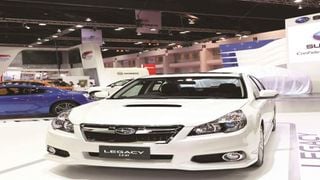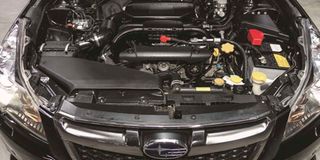
Subaru Legacy 2.5 GTcar.
| PoolDN2
Premium
I want to convert my Subaru Legacy 2005 BL5 to turbo and manual transmission
Hello,
Thank you for your educative and eye-opening articles, which I look forward to each Wednesday. Now, I own a Subaru Legacy 2005 BL5, naturally aspirated. This car has served me very well for almost six years now. I feel attached to it. I have upgraded to a Mercedes W204 2013, but since I feel attached to the BL5, I want to keep it and convert it into turbo.
My idea would be conversion to turbo WRX and change the transmission to manual.
The cost here is not so much of an issue, the end product is what excites me. What would be your opinion on this project? Pros and cons? Cost not being the issue, would you rather build a 2006/7 or a 2005 BL5? What’s the difference?
Thank you, continue this good work
Marvin
Hi Marvin,
Go for it. You’ll be surprised at how easy the project will be and how awesome the end product will be. The ease of the project is due to Subaru’s use of modular structures for their drivetrains, making the engines and transmissions interchangeable plug-and-play items, sometimes across different models. A good example is my former pride and joy, a BH5 Revision D Legacy GT-B E Tune II, the infamous “El Turbo”. I swapped out the original twin turbo EJ208 engine for a Version 7 Impreza WRX block and it fitted like a glove. The cherry on top was when I discovered that the transmission ratios in the Legacy matched the output characteristics of the Impreza engine. Cue a load of fun on the Southern Bypass...

Subaru Engine.
So, the pros are many. It is cost effective: there is a reason Subarus are referred to as “cheap horsepower”, you can get a WRX engine for just about Sh100,000, give or take a few thousands here and there. Manual transmissions are even cheaper. The modular platform means you take out one component and install another with little or no modifications to the existing structures.
Cons? I can barely think of any. You may not qualify for Concours D’Elegance because the car is not original - I’m fishing here because I really don’t see any downsides to this project.
I honestly don’t know the difference between a 2005 BL5 and 2006/7 one, other than that the latter is newer. I may go for the older one because it will be cheaper and less likely to have electrical gubbins such as SI Drive to gum up the modification works that you plan to do. One of the rules of project cars is to start cheap, irrespective of how long your money may be.
All the best with your build.

Racing cars.
What’s the difference between horsepower and engine cc, and is there a relationship between Torque and RPM?
Dear Baraza,
What poppin' (Get it? Cause cars have boots and bonnets that poop when opened!! Ha...) I am an avid reader of your column - used to sneak some newspapers in high school and read them. This is my first time to ask a question on this forum.
I am a university student and a car enthusiast and there are two terms that have been confusing me that I would want you to unpack for me. Horsepower and Engine cc, what is their difference when describing a car?
Moreover, what is the relationship between Torque and RPM?
Thank you in advance,
Kind regards,
Hawk the OG (H.T.G)
Greetings Hawk The OG (H.T.G),
That greeting sucks (Get it? Because during the intake stroke of the four-stroke cycle, the engine sucks in air! Ha...) I am an avid writer of automotive editorials in the Daily Nation and I'm glad to have a religious follower in you. There is a first time for everything, and this being your first inquiry to this column, let us make the experience as memorable as we can. So now, horsepower and engine cc are two very diverse concepts that incidentally are not mutually exclusive. Both are measurable, but one needs slightly more proprietary tools to quantify than the other. Let us break it down.
Engine Capacity
We start with the easier one: engine cc. CC means cubic centimeters, and is a unit of volume. The number preceding that unit is the total volume swept by all the engine cylinders. I will assume you know what a cylinder is. This is how to calculate the engine cc:
Get the volume of one cylinder. This is simple primary school calculation: base area times height. Base area is simply the area of a circle because cylinders are circular (duh!). So, pi times the square of the radius of the cylinder gives you the base area, then multiply this by the height of the cylinder, which we call the stroke. Once you have this, then multiply that figure by the number of cylinders. The end result is the engine capacity in whatever units you were working with - Americans sometimes refer to cubic inches rather than cubic centimeters. To give the capacity in liters, simply divide the figure you got by 1,000.
Practical example: I have a BMW E34 525i. I know the nomenclature is already a giveaway of its engine capacity but let's pretend we haven't seen it. I want to know the engine capacity of this car. The technical specs indicate a bore of 84mm (8.4 cm) and a stroke of 75mm (7.5 cm). What is its engine capacity?
We start with the area of one cylinder: pi (3.14) times the square of the radius. The radius of the cylinder is half the bore, so it's 4.2 cm. The area (pi times the square of the radius) is 3.14 times 4.2 times 4.2 again. This gives 55.39. We multiply this base area times the height which is the stroke of the engine: 55.39 times 7.5, to get 415.42. This is the volume of one cylinder.
But my car has six cylinders, so I have to multiply the volume per cylinder times number of cylinders to get the engine capacity. 415.42 times 6, which is 2492.5. My car's engine capacity is 2493cc, which is typically rounded off to 2500cc. That is what the "25" in "525i" stands for. To express this figure in liters, divide the figure by 1000 to get 2.5. Mine is a 2.5 liter engine. Savvy?
I said this is the easier one because you don't need any special tools to measure engine capacity, a ruler is enough. A ruler, a pen and paper are all you need to measure engine capacity (also called displacement). Horsepower is a whole other kettle of fish...
Horsepower
Engine power is typically expressed in horsepower but sometimes other units such as kilowatts, donkeystrengths, llamathrusts and zebraforce are used, some more commonly than others. This is how much work an engine can do. Please note: it is not how heavy a load it can pull, that is torque. It is how much work, that is, how fast it can apply that torque.
The best way to express it is this way. There is a man. This man can lift a 90kg sack, tops. At 91kg, he cannot move that sack at all. So the maximum torque he develops is 90kgm (we'll talk more about torque shortly but this is the basic explainer). There are two subsequent scenarios that follow, both of which explain what power is.
Once he has lifted that sack, power is how fast he can run while carrying that sack. Some people can run fast with that 90kg sack despite being unable to lift 91kg. Some people will run slower with that 90kg sack but this will not allow them to lift 91kg either. The reasons behind this are too technical to get into here, but they're why automotive engineers are well paid and also why engines cost so much money.
The second scenario is slightly similar in that our man here can lift a 90kg sack a meter off the ground (torque). Let us, for the sake of example, assume he is lifting 90kg sacks off the ground and loading them on a conveyor belt that is exactly a meter high. Power is how many 90kg sacks per second or per minute he can load onto the conveyor belt. Again, some people can load those sacks really fast despite the fact that they cannot lift 91kg. Others will load the sacks slower but this will not allow them to lift 91kg either.

Speedometer
So, in a nutshell, power is the rate of doing work. But what is torque?
Torque
Torque is the ability to do work. In the example above, the torque applied is 90kgm, which is the ability to move 90kg a distance of one meter. Sounds simple, no? It is, until you have to wrap your head around how torque is applied. This is where the issue of transmissions (a.k.a gearboxes) comes in, but again, we will not go down that rabbit hole just yet.
Pundits of pugilism know the fact that Mike Tyson's right hook was measured at 60kg. If he throws that right hook over a distance of one meter, can we then say that he has 60kgm of torque? This implies that there is enough torque in his right hand to go to tug-of-war against a Landcruiser VX packing a twin-turbo diesel V8 (63.7kgm). Why buy a V8 when you can get Mike Tyson to push you around with one hand, then?
Many of us, myself included, can actually lift a 90kg sack one meter high before breaking into a sweat, triceps start vibrating at low frequency, veins start showing on our necks and our girlfriends ask us to stop the nonsense before we throw out our backs and have to visit a physiotherapist. Does that mean I have more torque than Mike Tyson's coma-inducing Fist of Righteousness (see what I did there)? Does that mean I have the same torque as a 67-seater turbocharged Isuzu bus (98kgm)?
While I have oversimplified the concept of torque, in the real world, torque is applied in a rotational manner, so torque is in reality a twisting force, not a linear push. Those examples are all linear, so that is not torque, but it is how to measure torque. The amount of force Iron Mike hit you with to shut you up for good is the same amount of force coming from the engine of a 1VD-powered Landcruiser, the difference is "Tython" hits you straight while the V8 engine rotates. Now, Tython can probably thpin... thorry, spin a shaft with enough force to move a 65kg load over a distance of one meter but there is a limitation: his wrists. The guy is strong, but can he rotate a shaft, with that force, at 500rpm, the idling speed of the diesel V8? I don't think he can even get to 20rpm.
And that is why it is not a good idea to get Iron Mike to push you around with one hand. He can't match the output of a Landcruiser. Just buy a diesel VX.
Relation between torque and rpm
Ideally, there is a certain range within the rev range, what we call the "torque band" where the maximum torque can be applied, before the torque drops off as the rpms go higher. The analogy here is simple: you can lift a sack one meter off the ground. There is a limit to how fast you can do the lifting before you either cave in, or have to reduce the load in order to move any faster. That is why vehicles have transmissions, these help the engine to stay within the torque band, the optimum load-lugging rev range, while increasing speed.
For more explanations like this, stay tuned. Thanks and see you next week.
Email your motoring questions to Baraza: [email protected]





